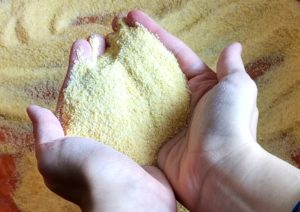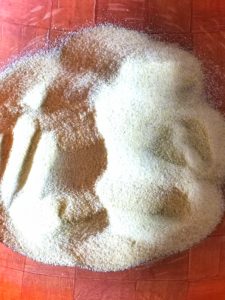Couscous is a huge part of our traditional food as Algerians. As I said in my previous article about my vegan journey, my Algerian heritage and especially my grandma’s cooking really gave me a new meaning to food. What I remembered the most is the time we spent all together (my siblings and me) watching my mom cooking the couscous. I’m not talking about store-bought couscous, the one you have to simmer for a few minutes before eating right away. I mean the medium wheat semolina you turn into couscous. Of course in Algeria my grandma uses semolina to create couscous seeds and let it dry to the sunlight so it takes more time. Here in France, we buy couscous seeds and it can be long as well. Watching my mom and then my sister cooking it was so fascinating to me because it took so much time and effort but was so worth it in the end. Before diving deeper on the way we cook the couscous, I want to share with you a bit of historical and traditional background.

The art of making couscous – Illustration By Joana (@joanalabananaa on instagram)
Couscous’s origins are kind of vague but most North African population has couscous as the main food to their day-to-day diet. Just like in a lot of Asian and Southern African countries where the population eats rice in most of their meals.
North Africans added couscous to their meals thousands of years ago. With that, the couscous cooking technique passed on through the generations until this day. However, Algerians, Moroccans, Tunisians, and Libyans all have their own version when it comes to cooking the couscous.
Today, I wanted to explain to you the Algerian version of couscous (specifically my Berber grandma version). What’s funny about it is that no one has the same couscous recipe. Although my grandma taught my mom and my sister, all three of them gave a different version of the couscous. Never the same taste. This is what I like about this dish, it is so versatile and everyone can have their own versions to it!

oznorCO
What doesn’t really change is that in most Algerian households we have a big wooden bowl where we work the semolina by hand. We also have what we call in French a “couscoussier”—a huge cooking pot with a steamer to cook the couscous. As you can tell by the name. Well, I would be kind of disappointed if “couscoussier” wasn’t about couscous.
In Algeria, couscous dishes vary depending on the region. In the west, couscous is prepared with a lot of spices but even in the same area, there are a lot of different flavors of couscous. For example, in Tlemcen, people put saffron in their couscous whereas in other cities, the couscous is filled with the smell of pepper and cinnamon. In the east coast, the couscous’s sauce is more spicy and filled with different kinds of meat. In the south, we sometimes use barley instead of semolina to prepare the dish.
In Kabylie, where I’m from, I would say we have a healthier recipe for couscous (at least in my grandma’s home). We use all kinds of veggies such as beans and pumpkin, but we also use plants such as cardoons.

oznorCO
To form the couscous, you have to put semolina in a big wooden bowl. By feeling with your hands, you add water and a bit of olive oil. Then you mix it. The semolina is not supposed to be soggy or mushy. What is hard about the preparation is that it’s a matter of hand feeling, we don’t really measure anything, everything is about how the semolina feels through the hands. After having a good texture, you are supposed to put the semolina in the “couscoussier” (literally a big pot filled with water and an iron steamer with small dots where the couscous is supposed to be). It’s kind of like how you steam dumplings without parchment paper and the steamer is made of iron. In other areas of Algeria and other north-africans countries it’s different. Under the steamer, meat is cooked with some veggies so the flavors getting out of it get soaked up from the couscous to be flavorful. In Kabylie, we rarely do that though. Although most of the couscous dishes are filled with a lot of meat in other areas, in Kabylie we have many different veggie couscous dishes. We even eat couscous with fruits: grapes and even raisins, for example.
After the steaming process, you have to put the couscous back in the wooden bowl and mix with your hand again with oil and water. Then steam again.
Unfortunately I can’t (for now) give you a full recipe because the cooking technique changes from one person to another.
Couscous is a huge part of our culture. During weddings, all the women of the families come together to prepare the couscous and the sauce. I had the chance to experience that and it was wonderful. Some people may think: why are women the only ones to prepare the dishes for everyone?
Actually it doesn’t really matter who does it, because everyone has a role to play in the planning of the wedding and compared to Western weddings, our traditional wedding lasts for a few days in a row. It’s also an opportunity for us to create bonds with the different families and to talk and have fun between women. We cut the veggies together, clean them, and cook them together. We really give a lot of meaning and love to our food as it takes a lot of time to prepare. So when we eat it, we can feel the intentions going through the food and we enjoy the flavors even more.
I love sharing couscous with my friends and I always hear from them, “how do you make it so flavorful?” “How is a dish so simple yet so warm and delicious?” What is different is that with the cooking technique I shared with you, even the couscous without the sauce is flavorful. That is the beauty of it. Doing a dish with love and effort makes a difference. Enjoying food isn’t always just about eating, it’s sometimes about cooking it from scratch and putting time into the making. A couscous dish always brings me comfort. Because it’s not just about having it in my mouth, it’s about what comes from it. Food is health. Food made with love is love for the body.
“Let food be thy medicine and medicine be thy food” said Hippocrates and I couldn’t agree more.
Get more like this—Sign up for our daily inspirational newsletter for exclusive content!




